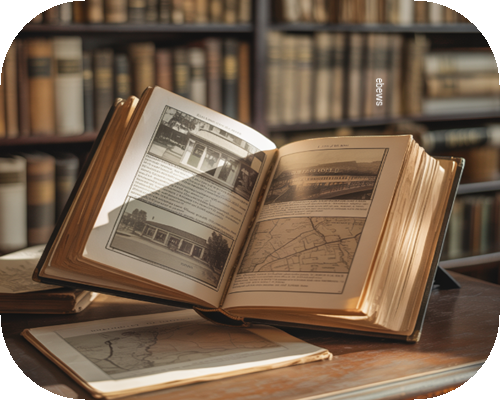Public libraries often feel like quiet neighbors. They don’t shout for attention but they hold the stories of a town in their shelves. Long before the internet ever existed libraries were already mapping local culture one page at a time. They have always been more than book depositories—they are memory keepers.
Across cities big and small libraries partner with local historians teachers and volunteers to collect photos letters and oral histories. These efforts might start with a single dusty box in someone’s attic. Soon that box becomes part of a community archive. Old street maps postcards menus from long-gone diners—each one adds to the puzzle of place.
Zlib helps bring together useful materials for readers who might never have time to visit a physical archive. It offers access to scanned books newspapers and documents that are out of print or stored in places difficult to reach. When combined with local efforts these materials enrich the historical record in ways that stretch beyond geography.
Community Archives Are Living Projects
A strong local history section in a library doesn’t just appear overnight. It grows from community curiosity. Often librarians find themselves fielding questions that lead to deeper discoveries. Someone wants to know who owned the corner bakery in 1940. Another wants a photo of the old train depot. Those small questions shape the larger search.
Many libraries run oral history programs recording conversations with elders who lived through wars migrations or economic changes. These voices give a face to timelines. A textbook might say the town lost its steel mill in 1978. But a neighbor’s story tells how it felt to lose that job and what came next.
To keep these connections alive and accessible libraries rely on more than just shelves. They create digital catalogs host exhibits and even lend out old recordings or film reels. But there are still challenges like funding storage and copyright concerns.
What Libraries Preserve Beyond Books
Here’s where things get even more interesting. Libraries are saving parts of life that don’t come bound in covers. And they do it with care:
1. Photographs That Speak Volumes
Family albums sometimes end up in the library’s archive not by plan but by trust. A granddaughter brings in old Polaroids of community picnics parades or store openings. These aren’t just snapshots—they’re keys to memory. A child in a sailor suit holding a balloon might help identify a whole generation. Through these visuals people reconnect names with faces and streets with stories. Even local artists sometimes dig through archives for inspiration finding details lost to time.
2. Newspaper Clippings That Fill the Gaps
Before blogs there were columns and classifieds. Local newspapers captured what mattered to people in that moment—a lost dog a bake sale a school board meeting. Libraries often microfilm or digitize these pages. What seems like daily fluff can later reveal social changes patterns of migration or economic shifts. Historians sometimes use obituary sections to trace entire family trees or discover public sentiment during times of crisis. Each faded column becomes a thread in the wider fabric of community identity.
3. Personal Diaries and Letters
When private documents become public records they carry the weight of emotion. Diaries offer intimate windows into daily life. A teenager in the 1930s wondering about the future a farmer recording droughts or births or prices—all these moments stack up. Letters between soldiers and home tell what official reports never could. Libraries collect and transcribe these documents with respect often asking families for context. Reading these is like time travel without the machine.
Libraries then weave all this into public programming. One collection sparks a panel discussion another becomes part of a school visit. Displays rotate keeping interest alive. And in doing so they give people back their own stories.
Technology Gives New Life to Old Records
Digitization is a big word for something simple: keeping history alive. A brittle photograph can’t be handled by many hands but a scanned version can be seen by thousands. Libraries use scanners metadata and cloud storage to preserve what might otherwise crumble away. They partner with universities nonprofits and yes even e-libraries to stretch their reach.
Some even crowdsource their archives asking the public to help identify unknown faces or transcribe faded handwriting. That turns preservation into participation. Suddenly the past isn’t a closed book—it’s a conversation in progress.
The Quiet Power of Place
What makes libraries so central to local history is not just what they hold but how they share it. People walk in with vague questions and walk out carrying pieces of their own heritage. A map a name a sound clip of their grandfather telling a joke.
In that moment the library becomes more than a place to borrow books. It becomes a bridge between what was and what still matters.
How useful was this article ?
Click on a star to rate it!
Average rating 0 / 5. Vote count: 0
No votes so far! Be the first to rate this post.
We are sorry that this post was not too useful for you!
Let us improve this post!
Tell us how we can improve this post?









Related Articles
HOLY COW! HISTORY: The Deal of a (Very Long) Lifetime – Inside Sources
HOLY COW! HISTORY: When Hitler Invaded England–In 1974 – Inside Sources
HOLY COW! HISTORY: The Daredevil Who Dressed the World – Inside Sources
HOLY COW! HISTORY: Two Trains, One Track, Big Problems – Inside Sources
HOLY COW! HISTORY: Why A Store Kicked Out a Royal – Inside Sources
HOLY COW! HISTORY: The Return of Room 8, the School Cat – Inside Sources
HOLY COW! HISTORY: Bread’s Big Break – Inside Sources
HOLY COW! HISTORY: Hitting the Road With Henry, Harvey, and Tom – Inside Sources
Recent Articles
Opinion: When Children Walked to School – Michael Barone
Nvidia to invest $100 billion in OpenAI to help expand the ChatGPT maker’s computing power – Associated Press
Supreme Court will weigh expanding Trump’s power to shape agencies by overturning 90-year-old ruling – Associated Press
How Israel could retaliate against the growing push for recognition of a Palestinian state – Associated Press
Open House meeting for the Effluent & Wastewater Pipelines & SR89 Improvements Project
Celebrating Cultures through the Stories They Tell: Yavapai College’s “Transforming Traditions” opens Oct. 3
Back to Home Page